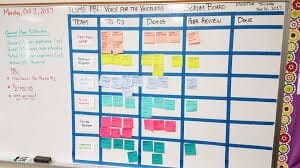What is SCRUM?

Why I Scrum: Using a Project Management Tool for PBL
SCRUM tools support Scrum ceremonies, including planning sprints, keeping track of daily work, refining backlogs, and using data from the past to keep improving. When people work together on these tasks, Scrum tools help them stay focused by connecting the work to its value.
If you are a teacher who works on projects with students in PBL, you know that PBL can be messy and hard to track due to the multi-step process. Todd LaVogue, a design thinking teacher at the Conservatory School in North Palm Beach, Florida, knows all too well. LaVogue, author of Why I Scrum: Using a Project Management Tool for PBL article, had difficulty keeping track of every student, every task, and every PBL project management process.
LaVogue saw a sitcom about a tech startup in Silicon Valley trying to get their product ready for consumer use, with a deadline approaching. LaVogue saw one frantic scene where the team started grabbing post it notes off a white board, working on the task written on the post it, and moving tasks from left to right through various columns on the white board. LaVogue began researching about this magical board online, and he loved that no scrum board images were the same. He began to change to a scrum board to fit the needs of his students.
Scrum Board Process in PBL
LaVogue felt no need to overcomplicate the process since scrum boards are configurable. LaVogue has this iteration with five columns:
| Team | To Do | Doing | Peer Review | Done |
| Team names or Deliverable names | Individual tasks on note cards or post it notes | Tasks remove from To Do column and return as Doing | Members of another team give cool or warm feedback | Peer group initial the task card as complete and return to Done column. |

Team Column: Only team name or deliverable names are listed.
Reason: LaVogue had no interest in student progress monitor boards. LaVogue did not want to confuse any classroom guests into thinking that is displayed.
To Do Column: Teams create individual tasks on notecards (cut in half to conserve board space) or post it notes. All tasks start in “To Do” section. Once removed from the board to work on, that card returns to board in the Doing column.
LaVogue helped teams to create list of all tasks necessary to complete deliverables.
Peer Review Column: Before tasks are moved to Done column, members of another team will analyze the work and provide warm and cool feedback.
Done Column: Once the peer group initials the task card as complete, the card is placed in the Done column.
LaVogue wanted to keep the scrum board idea fresh for his students, so he had created scrum boards using various materials and designs, while keeping the five columns the same.

LaVogue believed on “large scale, multi-step projects, scrum boards are an excellent way to keep students on track.
LaVogue and his students modeled when you are not currently working on a task, to approach the scrum board and select a task. This is one way to ensure everyone has something to do.
Real-World Application in PBL
In LaVogue opinion the use of scrum boards across many companies adds another level of real-world application. LaVogue believed peer review is the most important column on the board for his students. Students looked for feedback to find out what revision is necessary on their task. Students gave feedback work on important thinking and communication skills.
LaVogue explained that once the task has gone through peer review and revised to the satisfaction of all involved, sign off is completed and moved into the final column. LaVogue noted “The sense of student ownership in creating the tasks, teams and deliverables makes the scrum board the focal point of student-centered learning.”
Keep Learning
The Key to Create Authentic Project Empower Student Learning
Scrum Boards are Good for Teachers
LaVogue typically works with large group of kids during a PBL cycle. LaVogue believes scrum board helps him to keep track of all the teams. LaVogue looks over the scrum board a few times during classes to identify ways he can help.
LaVogue gives an example of a task for one team that could be to create a 3D printed project. LaVogue will check to ensure the team has all the tools and/or skills to complete that task.
On exhibition night, students develop ownership of their learning and ownership of their deliverables. LaVogue need not create some exaggerated reason students are doing what they are doing. The students created task. The students created teams. The students created deliverables.
LaVogue has become a guide to help kids develop the skills to make it all happen.
Scrum Board Example
LaVogue provides one example of what goes on in scrum board for his class. Driving question for a Project:
It focuses on locally threatened or endangered wildlife. Students want to create video games to educate the public about specific species that interest them.
Task Examples:
Students would create tasks and add to the “To Do” column of their scrum board, and they are:
Research video game creation platforms and select one.
Identify common themes to the most popular video games
Research the Hero’s Journey by Joseph Campbell
Research your selected species.
Create initial game character drawings.
Write a draft of your endangered species journey to include elements of The Hero’s Journey
Storyboard your game.
And more —
Give Scrum Board a Try
LaVogue points out scrum board has helped his students stay focused and organized. A scrum board helps them to visualize their plan. It helps them see the big things can be done with a plan and an understanding that it is a multi-step process to reach the finish line.
